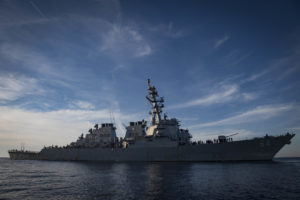Last week, top Navy leaders told Congress they no longer plan to extend the service lives of all DDG-51 Aegis-class destroyers to reach 355 ships.
“Service life extensions can be targeted, physical changes to specific hulls to gain a few more years, or a class-wide extension based on engineering analysis,” Assistant Secretary of the Navy for Research, Development and Acquisition James Geurts and Deputy Chief of Naval Operations for Warfighting Requirements and Capabilities (OPNAV N9) Vice Adm. James Kilby told Senate Armed Services Seapower subcommittee in written testimony on March 4.

“The Navy has evaluated the most effective balance between costs and capability to be removing the service life extension on the DDG-51 class; extending the services life of the most capable ships in the cruiser fleet while removing the four cruisers that have the least effective ballistic missile capability; and delaying the accelerated retirement plan for the mine countermeasure ships by one year,” the testimony continued.
This a reversal of part of a plan to reach 355 ships faster than in previous 30-year shipbuilding plans.
In 2018, Vice Adm. William Merz, then-deputy chief of naval operations for warfare systems, told the House Armed Services Seapower subcommittee upon finishing a Naval Sea Systems Command analysis the Navy found the entire DDG-51 destroyer class can be extended so each ship reaches 45 operational years (Defense Daily, April 13, 2018).
Merz currently is commander of the U.S. 7th Fleet.
At the time, he said the class-wide extension would allow the Navy to reach its 355-ship goal by the 2030s, albeit not in the preferred mix of ships.
“Through the terrific work of the NAVSEA engineers, we’ve come through that, I’d say, pretty quickly,” Merz said at the time.
By extending the entire class’ life expectancy, “then we can roll in the right maintenance and modernizations much more efficiently, much more affordably for the entire duration of the class,” he added.
Merz also told reporters at the time this is a hull, mechanical and electric work extension, with every destroyer in the modernization pipeline.
Merz argued that extending the life of the full class allowed the Navy to plan the modernizations more efficiently. “We can pace it, plan it, fund it efficiently as opposed to one and done, one and done, one and done,” Merz told reporters.